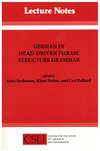

|
|
|
|

German in Head-Driven Phrase Structure GrammarThese essays apply the syntactic theory of Carl Pollard and Ivan Sag—Head-driven Phrase Structure Grammar (HPSG)—to a formal study and analysis of German grammar. A wide variety of fundamental and well-known phenomena in German grammar are addressed, including the German passive and impersonal passive, various Mittelfeld and Vorfeld word-order phenomena (including auxiliary stacking and the distribution of adjuncts), and the structure of phrasal constituents. linguistic issues include the treatment of idioms, word-order variation and phrase structure constituency, subcategorization, complementation, argument structure, case assignment, lexical rules, and syntactic ambiguity. The theoretical background for these essays can be found in Information-Based Syntax and Semantics and Head-Driven Phrase Structure Grammar, both by Pollard and Sag and available from the University of Chicago Press. is professor of computational linguistics and chair of humanities computing at the Rijksuniversiteit Groningen. is a computational linguist at the German AI Center in Saarbrucken. is associate professor in the Department of Linguistics at Ohio State University. Contents
12/1/93 ISBN (Paperback): 1881526291 (9781881526292)
Subject: Linguistics; Germanic Languages--Grammar; Head-driven Phrase Structure Grammar (HPSG) |
Distributed by the
University of Chicago Press |
|
pubs @ csli.stanford.edu
|
CSLI Publications
Stanford University Cordura Hall 210 Panama Street Stanford, CA 94305-4101 (650) 723-1839 |